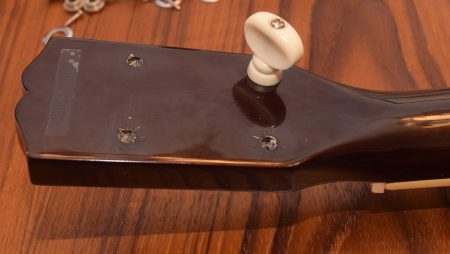My resonator ukulele sounds really neat, but has horrible tuning pegs. They are friction posts and get whacked out of tune every time I put them in the case. After a lot of months of regular playing and re-tuning I decided to upgrade to geared tuners. The old tuners are shown below and only required very small holes.
The holes on the top side are large enough for my new tuner to go in, but the bottom side is way too small. The new tuner (below) has a large shoulder that must be accommodated.
I carefully drilled out the backside and made sure not to break through to the front. There was a little chip-out of the back paint. Maybe not paint, I don’t know what it is.
The chips and hole edges are easily covered by the tuner flange. I didn’t have a drill bit small enough to pre-drill the screws included. Instead I used an awl to push a good starting hole, and employed some screw wax to help them go in. Everything went in smoothly with no damage to the screw heads. After a few days the strings relaxed and everything stays nicely tuned. Thinking about upgrading from friction to geared tuners? Do it!

















